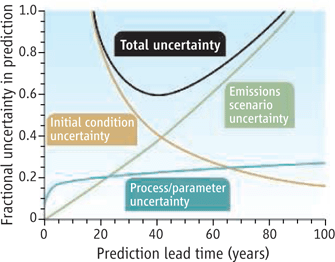In a nice example of how complicated climate feedbacks and interactions can be, Sitch and colleagues report in Nature advance publication on a newly modelled effect of ground level (or tropospheric) ozone on carbon uptake on land (BBC). The ozone they are talking about is the ‘bad’ ozone (compared to ‘good’ stratospheric ozone) and is both a public health hazard and a greenhouse gas. Tropospheric ozone isn’t directly emitted by human activity, but is formed in the atmosphere as a result of photolytic reactions related to CH4, CO, NOx and VOCs (Volatile Organic Compounds like isoprene, benzene etc.) – the so-called ozone precursors.
It’s well known that increased ozone levels – particularly downwind of cities – can be harmful to plants, and in this new study with a carbon-climate model, they quantify how by how much increasing ozone levels make it more difficult for carbon to be sequestered by the land biosphere. This leads to larger CO2 levels in the atmosphere than before. Hence the ozone has, as well as its direct effect as a greenhouse gas, an indirect effect on CO2, which in this model at least appears to be almost as large.
Actually it’s even more complicated. Methane emissions are one of the principal causes of the rise of ozone, and the greenhouse effect of ozone can be thought of as an indirect effect of CH4 (and CO and VOCs). But while NOx is an ozone precursor, it actually has an indirect effect that reduces CH4, so that the net impact of NOx has been thought to be negative (i.e. the reduction in CH4 outweighs the increase of ozone in radiative forcing – see this paper for more details). This new result might prompt a re-adjustment of that balance – i.e. if the ozone produced by NOx has a stronger effect than previously thought (through this new indirect mechanism), than it might outweigh the reduction in CH4, and lead to NOx emissions themselves being a (slightly) positive forcing.
In a bizarre way this is actually good news. There are plenty of reasons to reduce NOx emissions already because of it’s impact on air pollution and smog, but this new result might mean that reductions wouldn’t make climate change any worse. It also, once again, highlights the role of CH4 (the second biggest GHG forcing), and points out a further reason (if that was required) why further methane reductions could be particularly welcome in moderating future changes in climate and air quality.
 Between the difficulty of long-term weather forecasts and the impossibility of accurate predictions for economic conditions a century hence, there is a sweet spot for climate forecasts. This spot, maybe between 20 and 50 years out, is where the emissions scenarios don’t matter too much (given the inertia of the system) and where the trends start to be discernible over the noise of year to year weather.
Between the difficulty of long-term weather forecasts and the impossibility of accurate predictions for economic conditions a century hence, there is a sweet spot for climate forecasts. This spot, maybe between 20 and 50 years out, is where the emissions scenarios don’t matter too much (given the inertia of the system) and where the trends start to be discernible over the noise of year to year weather.